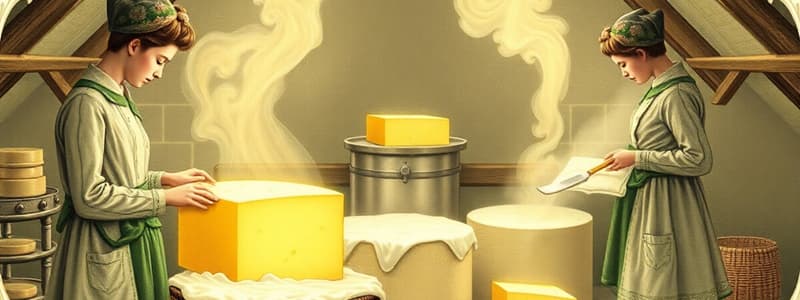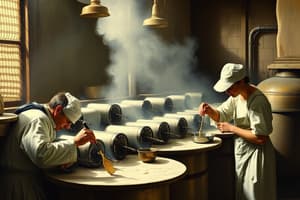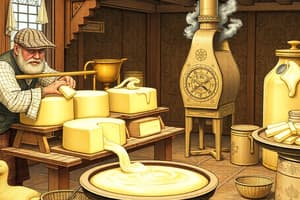Podcast
Questions and Answers
What is the maximum allowed moisture content in butter?
What is the maximum allowed moisture content in butter?
- 10.0%
- 16.3% (correct)
- 20.0%
- 12.5%
Which of the following factors increases the separation rate of cream from milk?
Which of the following factors increases the separation rate of cream from milk?
- Lower temperatures
- Higher temperatures (correct)
- Higher viscosity
- Smaller fat globule sizes
What is the purpose of adding calcium chloride in cheese production?
What is the purpose of adding calcium chloride in cheese production?
- To create a granular texture
- To enhance the action of rennet (correct)
- To improve the milk flavor
- To regulate acidity
At what temperature does rennet coagulation occur in cheese production?
At what temperature does rennet coagulation occur in cheese production?
Which of the following is NOT a process used in cheese making?
Which of the following is NOT a process used in cheese making?
What is the maximum percentage of butter culture recommended during butter production?
What is the maximum percentage of butter culture recommended during butter production?
Which of the following influences the loss of fat in skim milk?
Which of the following influences the loss of fat in skim milk?
What is the primary composition of acidic whey?
What is the primary composition of acidic whey?
What is the typical temperature for pasteurizing milk for cream production?
What is the typical temperature for pasteurizing milk for cream production?
Which factor does NOT affect the separation of cream from milk?
Which factor does NOT affect the separation of cream from milk?
Flashcards
Butter Composition
Butter Composition
Butter must contain at least 80.2% fat, a maximum of 1.5% curd, a maximum of 3% salt, and a maximum of 16.3% moisture.
Butter Culture
Butter Culture
A small proportion of bacteria (0.5-2%) added during butter making for flavour development.
Cream Separation
Cream Separation
Cream is separated from milk using a separator based on centrifugal force.
Cheese Coagulation
Cheese Coagulation
Signup and view all the flashcards
Cheese Starter Cultures
Cheese Starter Cultures
Signup and view all the flashcards
Butter Preheating
Butter Preheating
Signup and view all the flashcards
Pasteurization Temperature (Milk)
Pasteurization Temperature (Milk)
Signup and view all the flashcards
Acidic Whey Composition
Acidic Whey Composition
Signup and view all the flashcards
Rennet
Rennet
Signup and view all the flashcards
Clarification of Milk (cheese-making)
Clarification of Milk (cheese-making)
Signup and view all the flashcards
Study Notes
Butter
- Butter is a fat concentrate
- Composition: at least 80.2% fat, not more than 1.5% curd, not more than 3% salt
- Preheating: 35-40°C
- Pasteurization: 82-88°C (without holding) or 65°C for 30 min. or 74°C for 15 sec
- Butter culture: 0.5-2%
- Ripening: 20-22°C
- Ageing: 5-10°C
- Packaging & storage: -23 to -29°C, cooling (room temp.)
Cream
- Cream is separated from milk
- Separator: centrifugal device, separates milk into cream and skimmed milk
- Factors affecting fat separation: rate of fat globule rise (affected by fat globule size & temperature), temperature increases, viscosity decreases, velocity increases
- Gravity method: slow, no longer used commercially
- Centrifugal methods: used in industry
Cheese
- Cheese is a milk concentrate, mainly casein and fat
- Residual liquid is whey
- Additives: rennet (chymosin), calcium chloride, starters.
- Rennet: enzymatic coagulation, temperature 40°C, pH 4.6-4.7 (isoelectric point of casein)
- Calcium chloride: supports action of rennet
- Starter: produce lactic acid
- Salt: NaCl (1-4%)
- Texture: granular (e.g., Swiss)
- Moisture percentage is important with various different factors
Studying That Suits You
Use AI to generate personalized quizzes and flashcards to suit your learning preferences.




